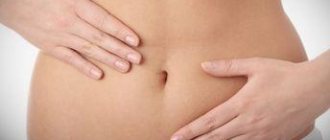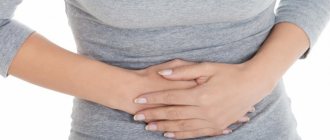The text is for informational purposes only. We strongly urge you not to use diets, resort to any therapeutic menus or fasting without medical supervision. We recommend reading: “Why can’t you go on a diet on your own?”
A diet for flatulence is a specific organization of a person’s diet, which is aimed at reducing gas formation in the intestines. The diet should ensure a complete supply of all the substances it needs to the body, help normalize intestinal motility, and reduce the processes of putrefaction and fermentation in it. The result of following the diet is the restoration of normal intestinal microflora and the elimination of conditions such as flatulence.
If we refer to the classification of treatment tables according to Pevzner, then in case of flatulence it is recommended to stick to table number five. However, drawing up any diet requires an individual approach and the exclusion of foods that a particular patient cannot tolerate. The energy value of the daily diet for flatulence is slightly reduced and amounts to 1600 kcal.
Principles of nutrition for flatulence
The principles of nutrition for flatulence are mandatory. Otherwise, the diet will not bring the expected benefits.
- Rules for eating
- Any quick snacks are strictly prohibited. Even if a person intends to eat any fruit, he must do so in a calm environment, chewing the food thoroughly. You should not carry on a conversation while eating. In this way, aerophagia will be eliminated, and the load on the gastrointestinal tract will be lower.
- You should not drink any liquid during meals.
- Approaches to the table must be made at the same time. This will enable the gastrointestinal tract to “remember” the hours of food intake and prepare for the process of its digestion and assimilation. Gastric juice, digestive enzymes, and bile acids will be released in a timely manner.
- Chewing gum for flatulence is prohibited. This is due to aerophagia during chewing and an unnecessary increase in gastric juice.
- Diet. It is necessary to stick to fractionation - eat in small portions, but up to 6 times a day. With this approach, beneficial substances will be broken down and absorbed in the intestines, and everything else will be quickly eliminated, without leading to putrefactive processes.
- Temperature of food consumed. Avoid eating excessively hot or excessively cold foods. Food should be warm. In this way, it will be possible to avoid excess production of stomach juices, which contributes to intestinal irritation.
- Food compatibility. Do not forget that there are products that are mutually exclusive. For example, milk and rough plant foods, sweet and salty dishes. If you do not adhere to the principle of food compatibility, then it will be much more difficult for the intestines to cope with the food bolus that enters it, which means that the risk of starting fermentation processes increases.
- Food processing. Products recommended for flatulence should be steamed, baked, boiled, or stewed. In this way, the principle of sparing the gastrointestinal tract will be observed.
- Drinking regimen and salt intake. Salt can have an irritating effect on the stomach and intestines, so its use is somewhat limited. You should not exceed the recommended dose of 8 g. As for the volume of fluid consumed, you should drink at least 2000 ml of water per day.
Products that restore intestinal microflora
There are a number of products that contribute to the development of dysbiosis:
- whole milk;
- fried potatoes;
- mashed potatoes with added milk;
- white bread and other baked goods in large quantities;
- sweet soda;
- sausage and smoked meats;
- pickled and canned foods.
Correct menu planning skills will once again help normalize the intestinal microflora. The main thing is that it always contains products that prevent the proliferation of pathogenic and opportunistic microflora, and therefore the development of putrefactive processes in the intestines:
- apples. They are recommended to be consumed in the morning, before the main meal. It will be enough to eat one small apple or even half in order to set the intestines the necessary rhythm of work;
- garlic. A clove of the vegetable can be eaten at any time, preferably on an empty stomach, and to avoid any unpleasant odor, drink the garlic with clean water;
- fresh vegetables, herbs;
- all types of berries;
- fermented milk products and feta cheese (moderate amounts).
Restoring the natural and “calm” intestinal microflora does not require serious treatment and radical diets with dietary restrictions. If you find that a certain product causes dysbiosis, simply eliminate it from your diet or minimize it. Replace sausage with natural meat, and milk with sour milk. Steam or bake food in the oven.
Thus, it is quite possible to solve many intestinal problems on your own. The main thing is to listen to yourself, realize which foods are most harmful to a person and adhere to simple rules in nutrition in order to maintain mental vigor and physical health.
What should you not eat if you have flatulence?
The list of prohibited products is quite extensive. First of all, these are all the foods that contribute to increased gas formation.
There are three such product groups:
- Products that contain coarse, indigestible fiber. Once in the intestines, such a bolus of food promotes the growth of microflora. Accordingly, during their life processes they will release more gases, which will lead to flatulence.
- Foods that contain simple carbohydrates. On the contrary, they break down very quickly in the intestines and provoke rotting processes.
- Products to which the patient has an individual intolerance. Most often, people are diagnosed with lactose deficiency, so whole milk and all products containing it must be removed from the menu.
Protein foods will contribute to the development of decay processes, since they are quickly broken down in the intestines. Unnecessary intestinal irritants include preservatives, food additives, essential oils, and organic acids.
So, here's what you can't eat if you have flatulence:
- Fresh baked goods;
- Millet bread, rye bread;
- Baked pies;
- Pasta;
- Dumplings and dumplings;
- Any fatty meat, including poultry and fish;
- Any stringy meat;
- Fatty broths;
- Pickles and marinades, even homemade ones, herbs, sauces;
- Any canned food;
- Salted fish, caviar;
- Lard, corned beef;
- Smoked products;
- Mushrooms, cooked in any form;
- Some cereals: pearl barley, millet, barley;
- Products containing animal fat: milk, full-fat sour cream, cream;
- Any representatives of legumes: peas, lentils, chickpeas, beans and dishes based on them;
- Any cabbage, raw onion, radish, daikon, radish, rutabaga;
- Raisins and prunes;
- Some fruits: melons, grapes, pears, apples, peaches, bananas;
- Nuts;
- Coffee, cocoa with milk;
- Drinks containing gases (except for specialized mineral waters on the advice of a doctor);
- Beer, kvass, kumiss;
- Chocolate, honey, jam;
- Potatoes and other products containing large amounts of starch;
- Soy products (soy milk, tofu);
- Eggs fried and boiled until fully cooked.
General principles of treatment
Proper nutrition - prevention of discomfort
Therapy for bloating begins after a maximum examination of the patient’s body and an accurate diagnosis. Self-treatment can be dangerous to life and health.
It should be remembered that folk remedies can only alleviate symptoms and not cure the disease. In addition, their use also requires consultation with a gastroenterologist.
Diagnosis and search for the causes of bloating include:
- laboratory tests (general blood and urine tests, biochemical blood test, stool test);
- Ultrasound of the abdominal cavity;
- colonoscopy, etc.
Computed tomography and magnetic resonance imaging of the abdominal organs may be needed. As drug therapy, antispasmodics are prescribed to relieve pain, enzyme preparations to stimulate the intestines and stomach, prebiotics and probiotics to restore microflora.
Diet for bloating is one of the important stages of effective complex therapy for diseases accompanied by this symptom.
What can you eat if you have flatulence?
Products that are allowed for flatulence are those that do not irritate the intestines, do not stimulate gas formation and do not have a carminative effect. A bolus of food entering the intestines must pass slowly and gently through it, without lingering or interfering with the processes of rotting and fermentation.
It is important to include in your meals those foods that promote the growth of normal microflora and are rich in iron, potassium, calcium and vitamins.
So, here's what you can eat if you have flatulence:
- Rusks made from wheat flour;
- Rye bran;
- Day-old bread or dried bread;
- Soufflés, meatballs, cutlets, meatballs made from lean animal meat (veal, rabbit) and poultry (cooking method: steam), skin must be removed;
- Seafood, low-fat boiled fish;
- Meat and fish broths;
- Fish and meat pates;
- Cottage cheese soufflé, low-fat biokefir, yogurt, yogurt and low-fat sour cream (if there is no lactose intolerance);
- Limited: potatoes, beets, carrots, zucchini, pumpkin;
- Parsley, dill, you can prepare dill water;
- Cumin and bay leaf are allowed as seasonings;
- Cereal porridges cooked in water: oatmeal, semolina, rice and buckwheat;
- Soft-boiled eggs, steamed egg white omelette;
- Green tea, cocoa in water, decoction of rose hips, blueberries, bird cherry, compotes, diluted juices.
In fact, the menu for flatulence only at first glance seems too strict. However, from a set of permitted products, you can prepare a considerable number of tasty and healthy dishes, against which the intestines will not rebel.
Milk and dairy products
Photo by Anita Jankovic / Unsplash
If you are lactose intolerant, milk and dairy products cause increased gas formation with an unpleasant odor. Lactose is a sugar found in milk, and the enzyme lactase is responsible for its breakdown.
When the body does not produce enough lactase, dairy products can cause diarrhea, abdominal pain, and severe flatulence within 30 minutes to two hours after consumption.
Flatulence is bloating due to the accumulation of gases.
Probiotic gut bacteria like Lactobacillus are able to process and absorb lactose. Their high levels in the microbiota may reduce symptoms of intolerance, especially in people whose diets are high in galactooligosaccharides (GOS).
Sample menu for flatulence
An approximate menu for flatulence may look like this:
| Breakfast | Lunch | Dinner | Afternoon snack | Dinner | |
| First option | Oatmeal. Cocoa on water. | Yesterday's bread with homemade fish pate or vegetable caviar. | Hake soup, chicken tenders with vegetable stew. Compote. | Baked apple. Ryazhenka. | Casserole with cottage cheese. Stewed chicken gizzards with rice. Green tea. |
| Second option | Cottage cheese pancakes, semolina porridge. Green tea. | A cheese sandwich. | Vegetable soup. Rabbit meatballs with buckwheat. Rose hip decoction. | Soft-boiled egg. Kefir. | Casserole with potatoes and fish. Steamed zucchini pancakes. Compote. |
Flatulence - clinical manifestations
Flatulence occurs at any age, is one of the most common complaints of patients, and is observed in 85% of patients with diseases of the gastrointestinal tract. Bloating may be seen in older and older adults as a symptom of anxiety. These patients should be examined with oncological suspicion, to exclude colon and ovarian cancer.
Bloating is a subjective feeling of fullness and distension of the abdomen, the appearance of hardness and tension in the anterior abdominal wall, excessive formation and discharge of gases, rumbling, and frequent belching.
Objective manifestations of bloating are:
- increase in abdominal circumference (patients often say: “I want to unfasten the belt at my waist”),
- loud rumbling
- loud belching
- uncontrolled release of foul-smelling gases.
Excessive (loud) belching is a violation of the motility of the upper gastrointestinal tract; there is an odorless belch or belching with regurgitation (bitter or sour belching). Often found in GERD, peptic ulcers, diseases of the biliary tract and gallbladder.
Belching may not be associated with the gastrointestinal tract, but may be determined by improper eating behavior, habits and mental factors.
With functional disorders, swelling and stretching are not constant, and differ in circadian rhythm. For most people, bloating occurs after eating, increases at the end of the day, and goes away overnight.
Products that cause flatulence
There are foods that cause flatulence when consumed, even in people who do not have problems with the gastrointestinal tract, these are:
- Any fresh baked goods, especially black bread and yeast baked goods;
- Raw vegetables containing coarse fiber and extractive substances: cabbage, radish, onions and garlic, turnips, radishes, spinach;
- Fatty fish, meat, poultry;
- Fried foods;
- All legumes;
- Hard-boiled eggs;
- Any smoked dishes;
- Nuts;
- Pearl barley and millet;
- Sugar and its substitutes;
- Whole milk, heavy cream, ice cream;
- Sweet raw fruits: grapes, bananas, apples;
- Any carbonated drinks: sweet water, kvass, beer.
In addition, exotic cuisine can increase gas formation, as the human digestive system gets used to the breakdown of foods that he eats daily. In this regard, unusual fruits that do not grow in their native climate zone can pose a danger. For example, for Russians, these are pineapples, avocados, kiwis, grapefruits and other exotics.
What fruits are least likely to cause bloating?
photo: unsplash / veeterzy
According to Dr. Lee, low-fructose fruits, which include strawberries , blueberries , oranges , grapes , pineapples and kiwis , are less likely to cause bloating. Wong adds that fruits low in various saccharides and polyols are also good choices, including pitaya , papaya , tangerines , clementines and unripe bananas .
Diet as a cause of constipation
The effect of food on intestinal motility and stool can be different, depending on mechanical, thermal and chemical effects. Some products weaken, others, on the contrary, strengthen. Chopped, fiber-poor foods reduce intestinal motor activity and slow down the movement of feces. The low content of organic acids and salt leads to the reabsorption of fluid (from the intestines into the bloodstream) and hardening of the stool.
Abuse of the following products contributes to stool retention3
- Refined food products: products made from premium flour, sweets, instant porridge.
- Chopped and pureed dishes: pureed soups, minced meat dishes containing a small amount of connective tissue, vegetable and fruit purees, jelly.
- Preferably consume thermally processed and chopped vegetables and fruits instead of raw ones.
- Fast-food, snacks, breakfast cereals, chips.
- Strong tea, cocoa and chocolate.
- Rare and heavy meals, eating on the go, overeating, frequent snacking3.
Up to contents
The whole truth about the benefits and harm of apples
Apples, present in the diet of almost every person, the benefits and harms of which directly depend on their proper consumption, are capable of supplying the human body with useful substances and microelements.
The beneficial properties of apples are determined by their unique composition. Despite the variety of varieties, the beneficial elements contained in these fruits are similar. About 80% of the total composition is water. The remaining 20% is fiber, carbohydrates and organic acids. The seeds of this fruit also provide certain benefits when consumed wisely.
The concentration of important components reaches its maximum in freshly picked fruits. The beneficial properties of apples are beyond doubt. When they are eaten, the human body receives the following substances:
- pectin, which improves intestinal activity and helps cleanse it of toxins;
- antioxidants that slow down oxidative processes in the human body;
- tannins, which have an anti-inflammatory effect in diseases of the cardiovascular and genitourinary systems in both women and men;
- tannins that prevent the precipitation of salts, which in turn is an excellent prevention of urolithiasis;
- vitamins C, B1, B2, E, P;
- The health benefits of apples are based on the content of minerals such as magnesium, potassium, calcium, zinc, copper, and chlorine. But most of all this fruit contains iron, which is responsible for the quality of blood and calcium, which is so necessary for the musculoskeletal system and the cardiovascular system.
Having an idea of the benefits of apples and how to use them correctly, you can not only enjoy the amazing freshness and taste of these fruits, but also use them for medicinal purposes.
The benefits of soaked, dried and baked apples
Which fruits are best to eat – soaked, dried or baked – is a question that interests many. The most useful product is considered to be fresh. But processed apples also retain many useful elements. The benefits of baked apples, dried or soaked, are determined by their unique composition.
Dried
When dried, the liquid evaporates from the fruit, and they lose a small part of vitamin C. But all other minerals, acids and vitamins remain. This product is characterized by a high content of iodine and pectin.
The benefit of dried apples lies in their ability to improve digestion, have a beneficial effect on intestinal function, and promote metabolic processes, which is especially important for women.
Baked
The benefits of baked apples are as great as raw ones. During heat treatment, the lion's share of important components is preserved. This product contains especially a lot of pectin.
Peeled baked fruits are an excellent remedy for chronic pancreatitis, cholecystitis, and intestinal diseases. In addition, this amazing product is able to restore the functioning of the digestive organs after abdominal surgery.
Baked apples, the benefits and harms of this delicacy have been known since time immemorial. Knowing the benefits of baked apples and how to use them correctly, you can safely include this product in your diet.
Soaked fruits
Pickled apples are a fairly common type of canning for the winter. In addition, their beneficial properties are in no way inferior to the fresh product. Soaked fruits contain quite a lot of fiber and plant fibers, being an excellent stimulator of intestinal function. Ascorbic acid, contained in large quantities, makes soaked apples an excellent remedy for stimulating natural immunity. This product is also rich in calcium, which makes it indispensable as a preventative against osteoporosis.
Apples for weight loss
The benefits and harms of apples for weight loss is a topic that is talked and written about a lot. The high fiber content has made this fruit an indispensable dietary product, popular among women who want to lose weight. However, many representatives of the fairer sex are concerned with the question: which fruits are better to use for weight loss - red or green, and what are the benefits of green apples?
The calorie content of this fruit depends on the variety and growing conditions. It should be noted that red apples have a higher calorie content (47 units) than green apples (35 units). Therefore, it is green fruits that are recommended to be consumed during diets.
Apple seeds
Many people consume this fruit without even leaving the seeds behind. Apple seeds should be consumed with extreme caution. The seeds contain large amounts of hydrocyanic acid, which is dangerous to human health. Moreover, if you manage to swallow 3-4 such bones, then it’s okay. However, they should not be used specifically.
This product is also rich in iodine content. However, it makes no sense to use apple seeds to compensate for this element, since they are not able to cope with such a task.
Contraindications for use
Despite the fact that the benefits of apples for the human body are tangible, there are still situations in which it is advisable to refrain from consuming this product. We'll look at which ones below.
- Duodenal ulcer and gastritis;
- Allergy sufferers should use red and orange fruits with caution;
- Tooth enamel does not like the acid contained in apples. After eating this fruit raw, it is recommended to rinse your mouth with water.
- People diagnosed with diabetes should consult a doctor before consuming this product.
The harm of apples in most cases comes down to contraindications related to health conditions.
Recently, the question has been actively discussed: is it worth eating this fruit at night? If yes, then for what? It should be noted that there is no consensus on this issue. On the one hand, eating apples at night is undesirable, because they contain sugar. On the other hand, it should be borne in mind that the fruit is digested quite quickly, so an apple eaten at night certainly will not cause difficulties in falling asleep or sleep disturbance. Thus, one of the best ways to combat night hunger is to eat a small apple at night.
Doctor-hygienist
State Institution "Center for Hygiene and Epidemiology"
Frunzensky district of Minsk"
Gapanovich Valentina,










